I started with a red cabbage from the store. I didn't think I needed the juice from a whole cabbage, so I just cut off a slice, and added the deepest-colored outer leaf.
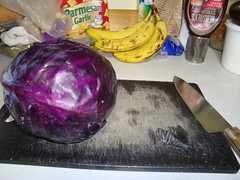 | 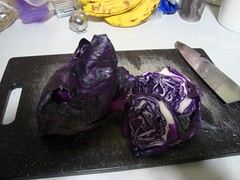 |  |
The instructions I was following said to blend the cabbage, but I chopped it; I didn't want to clean out the blender afterward!
The instructions also said to microwave the cabbage, but I tried cooking it in a small covered pot on the stovetop first. I put the pot on low heat for 5 minutes with 1/4 cup tapwater added. Then, I put the cooked cabbage in a glass coffee press and strained out as much juice as I could:
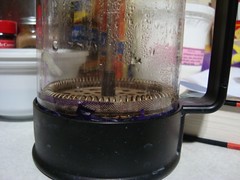 |  |
I didn't think it looked like very much juice, and I wanted to see if cooking it on the stove made any noticeable difference from microwaving it, so I took the cabbage out of the coffee press, put it in a microwavable bowl, added 1/4 cup more tapwater and microwaved it for about 4 minutes (low-power; we have a 20-year-old microwave that only HAS one power setting). Except for getting a lot more water left at the end (must have evaporated a lot in the pot), I couldn't see any difference.
I poured the liquid into a large glass bowl and soaked my coffee-filter paper that way. (I only had natural brown, not the bleached white that would probably show colors more clearly.) My daughter and I used clothespins to hang up the filter paper around the basement to dry (it was sleeting outside).
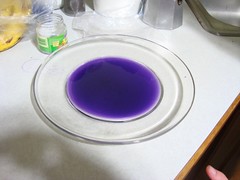 | 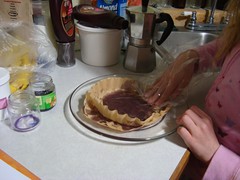 |  |
The next morning, we took one stovetop and one microwave-prepared sample down and tested the color-change with various substances (suggested on the about.com page I found my instructions on). I did think it was interesting that the filter paper didn't show a color change with our tap water, but when I rinsed out the extra liquid it turned bright blue in the sink instead of purple. I didn't see any color change with milk, either, even though it should have caused one according to the about.com page.
Stovetop paper 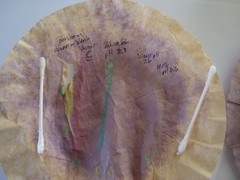 | Microwaved paper (also soaked more thoroughly)  |
A bit rough, but I think this will work just fine for figuring out if my dyebaths are acidic, neutral, or alkaline. At this stage I'm not going to worry about -exactly- what the pH value is. I do plan to take pictures but I'm sure it will be hard to get the lighting the same in each pictures (even in the two I have here the colors don't look quite the same; I think one had flash and one didn't).
No comments:
Post a Comment